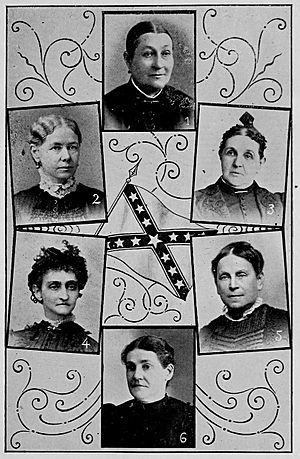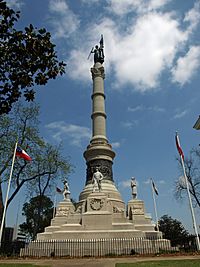Ladies' Memorial Association facts for kids
A Ladies' Memorial Association (LMA) was a group of women that started in the American South right after the American Civil War. These groups were created by women, for women. Their main goal was to honor Confederate soldiers by building monuments.
At first, they wanted to give soldiers proper burials. Later, they also wanted to remember the sacrifices of Southerners. They also helped spread the idea of the Lost Cause of the Confederacy. This idea looked back at the Confederate cause in a certain way. Between 1865 and 1900, these groups were very powerful in Southern culture. They set up cemeteries and built large monuments in important places. They helped unite white Southerners around a shared belief. This belief helped people heal and also had political meaning.
Contents
History of the LMAs
How the LMAs Started
The very first Ladies' Memorial Association began right after the Civil War ended. This was in Winchester, Virginia. This town had suffered a lot during the war. In 1865, a woman named Mary Dunbar Williams started a group of women there. Their goal was to properly bury Confederate soldiers whose bodies were found in the countryside. They also wanted to decorate these graves every year.
In the summer of 1865, the Winchester women asked for money in newspapers. Soon, donations poured in for the Winchester cemetery. People from Alabama gave a lot of money after a newspaper in Montgomery asked for help. Because of this, Stonewall Cemetery in Winchester opened in 1866. It was named after Stonewall Jackson.
Within a year, about seventy such groups had started across the South. Another early cemetery was set up by the LMA in Wake County, North Carolina. The Montgomery LMA's story shows that these groups were part of a bigger movement. They continued the work of "Ladies Aid Organizations" from during the war. They also got a boost when men in Montgomery formed a historical society in late 1865. News from other states like Mississippi and cities like Selma about women's groups forming in early 1866 also helped. After a strong plea in the newspaper, "the women of Montgomery... filled the sacred halls of the old Court Street Methodist Church on that beautiful Monday morning on the sixteenth day of April, eighteen-hundred and sixty-six!"
In Kentucky, the Cynthiana Confederate Monument Association raised money. They designed and put up the Confederate Monument in Cynthiana in 1869. This was the first of over sixty Civil War monuments in Kentucky.
In Montgomery, the LMA raised $10,000 for the Confederate Memorial Monument. This monument is on the grounds of the Alabama State Capitol. Alexander Doyle designed it, and it was put up in 1898. Monuments built by LMAs often included statues of soldiers. For example, in Petersburg, Virginia, there is a bronze statue of a Confederate soldier. It shows him dressed as a private, with his gear and an "old slouch hat."
In Athens, Georgia, Laura Rutherford led a soldier's aid group during the war. After the war, she turned it into a chapter of the LMA. When she died in 1888, her daughter, Mildred Lewis Rutherford, became the president for life of that chapter.
In early 1866, the Soldiers' Aid Society of Columbus, Georgia, became the Ladies Memorial Association of Columbus. They chose Evelyn Carter as president and Mary Ann Williams as corresponding secretary. Mrs. Williams wrote a letter asking Southern women to gather on April 26, 1866. She wanted them to decorate the graves of Confederate soldiers with flowers. This letter was printed in newspapers all over the South. Many women responded, and the Memorial Day holiday in the United States began. It got its name from the Ladies Memorial Associations that organized these events.
Two years later, on May 5, 1868, John A. Logan ordered all posts of the Grand Army of the Republic (GAR) to decorate Union graves with flowers on May 30. After this, the April holiday became known as Confederate Memorial Day. The May 30 holiday was called both Decoration Day and Memorial Day. The GAR officially named it Memorial Day in 1882.
How the LMAs Grew
These groups were made up of women. At that time, women were generally not seen as political. This helped Southerners realize the benefit of these groups. The LMAs could spread the idea of the Lost Cause of the Confederacy without seeming disloyal to the U.S. government.
According to historian Caroline Janney, women in the LMAs built on two ideas from the war. These were: women in the South organizing themselves, and white Southerners feeling united. LMAs and other women's groups also helped care for Confederate veterans. They also helped bring veterans home. The movement they started is called the "Confederate Memorial movement."
The popularity of these groups also grew because many felt the U.S. government did not respect Southern dead. Starting in 1866, scouts from the North collected Union soldiers' bodies. They buried them in national cemeteries. Confederate soldiers were not allowed in these cemeteries. Other cities soon followed Winchester's example. Many LMA chapters are still active today, such as in Montgomery (founded 1866) and Fredericksburg, Virginia (1870).
In May 1900, the different memorial associations from all Southern states had their first national meeting. This was in Louisville, Kentucky. They chose leaders for a national organization. Their historian, Margaret Cary Green Davis, explained the group's goals. She said they wanted to pass on their message of devotion to future generations. This devotion was to the memory of the Confederate Cause and its heroes.
Cultural Importance of LMAs
LMAs gave Southern white women a chance to show their dedication to the Lost Cause. At the same time, these women could organize in ways that did not challenge men's power. They also helped rebuild Southern men's sense of pride. Men who had lost their traditional roles could now honor the sacrifices of Confederate soldiers. This helped them feel strong again.
So, the LMAs helped people deal with the emotional pain of the Confederacy's loss. Even though they seemed non-political, they influenced public policy. They promoted and shaped the Confederate tradition. They also strengthened the social order they believed in. These women achieved things that men in politics could not. They stayed out of direct politics but skillfully handled difficult situations. They often got state support to make their version of history the official public memory.
The way these groups promoted public remembrance happened at a time when the presence of African Americans in public caused worry. Some scholars suggest this was part of a plan to maintain the existing social hierarchy. While the United Daughters of the Confederacy (UDC) often gets credit for turning military defeat into a political and cultural win, LMAs did this long before the UDC was founded in 1894.
See also
- Confederate Monument



